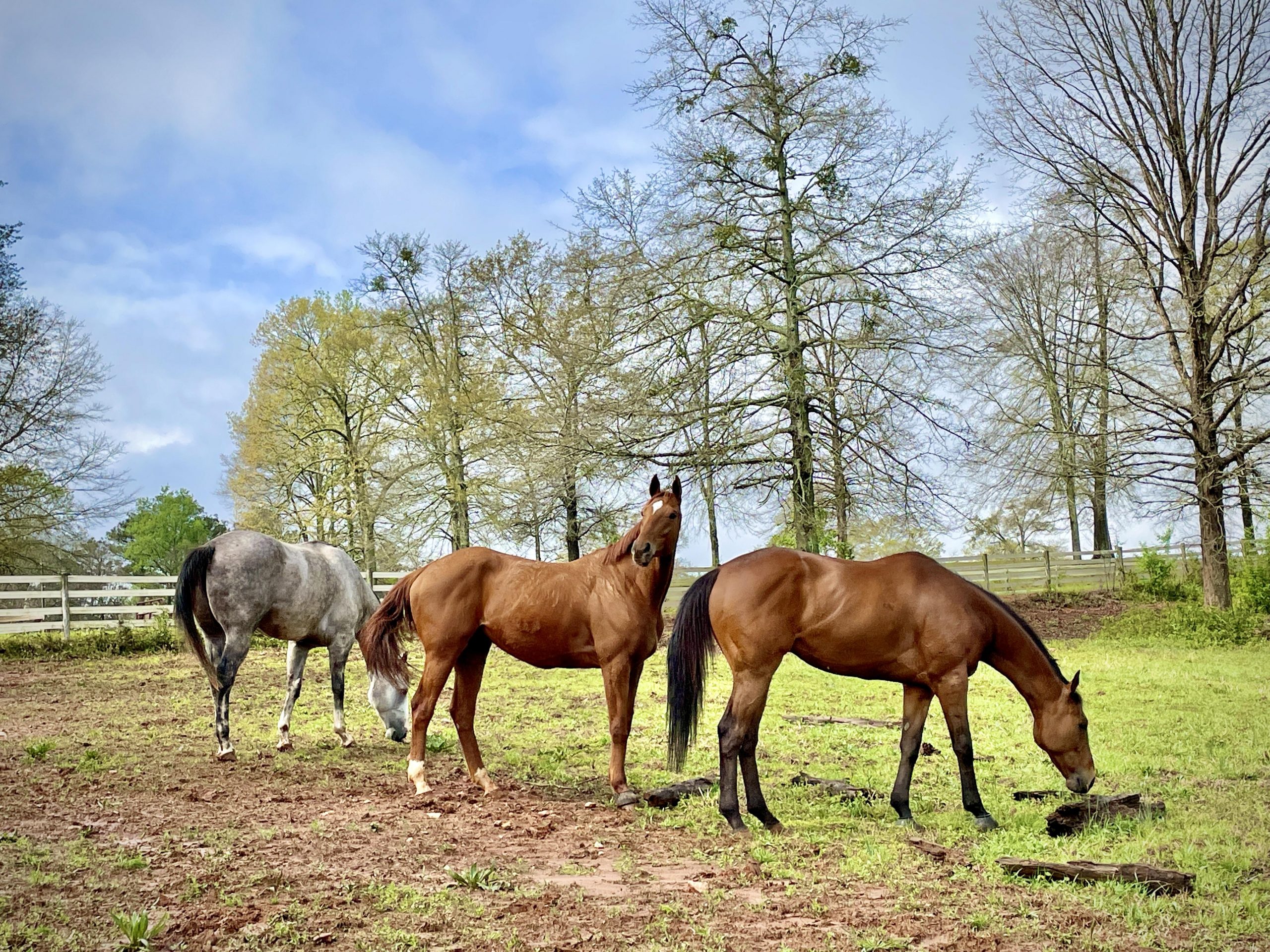
Thoroughbred Logic: Getting Turnout (More) Right
“He looked at one puddle-fence combination, but otherwise clicked around his courses, did everything asked and hung out like a seasoned gentleman all day. All it took was some trust under saddle and a better, more tailored-to-the-horse turnout situation.”
Welcome to the next installment of Thoroughbred Logic. In this weekly series, Anthropologist and trainer Aubrey Graham, of Kivu Sport Horses, offers insight and training experience when it comes to working with Thoroughbreds (although much will apply to all breeds). This week, come along for the ride as Aubrey offers her logic on finding the right amount of turnout for each horse.
Needles (JC: Needles Highway) is the horse in the barn with the most debatable Jockey Club name. Sure, it is a lovely road somewhere in both South Dakota and California, but it also makes my fancy pants four-year-old sound like a hardened addict. Having known him since he was a yearling, though, that moniker isn’t going to change. Comically, if you’re in my barn around stall cleaning/feeding/turnout time, it is also the name that is likely to be heard echoing off of the barn walls… well his name and Forrest’s (JC: Don’t Noc It) anyway.

Needles being a goober with Maggie Gilbert at the recent Big Cheese Eventing show at Ashland Farm. Photo by the Kivu Team.
Needles is annoying. Better yet, he is wicked smart, calculating, goofy AND bloody annoying. It is a combination that makes me love him more but frustrates the hell out of most everyone else who helps out around here. Ashley, who is fluent in .gif speak has a great John Travolta model for Needles — looks hapless, but will calculate like hell and confidently walk (not run) out the just-open-enough stall door.
Now, equine manners are critical in any barn, but are definitely required in a not-ideally-laid out, long-walk-to-the-field where we then bring in up to four young Thoroughbreds at a time. The challenge with horses like Needles and Forrest is that they will be prefect angel babies when required, but as soon as there is a new human or a chink in the armor, they pretend they have never been asked to deal with a bath, standing quietly in a stall while it is cleaned, or walk properly on a loose lead. Smart horses like that mean I spend time training the people, because I’m not entirely sure how I can train the overly intelligent equine to apply the rules (which they know damn well) more broadly.
Recently though, Needles has been getting more annoying. This type of annoying isn’t just smart and cute, it is concerning. He began stall walking, then weaving — clicking into some alternate universe where his eyes stop focusing on what is in front of him and where he just has to move his feet. He would trash his stall, liquify shavings, and generally wreak havoc. Something wasn’t right. Something definitely had to change.

Needles and a muddy Monk refusing to take a good photo in their initial turnout together. Photo by author.
This behavior came on the tail end of surgery and recovery. Needles is the goober who, while playing in his most excellent big rompy turnout, received a kick to the foreleg that sequestered and required surgery and long, slow, wrapped and stall-rested recovery. His transition from stall to small turnout to bigger turnout has been tough on his toddler brain, though thankfully, once I got him out and able to gallop around, riding him has become a non-issue.
Up until last week, he was turned out with Monk (Sydster) and Q (Quality Step) in the big field next to my driveway. It is the safer of the turnouts to my very pretty, but very steep lake field, so I figured it was the best thing for him. But after breaking out of the stall on a worker again last week, I had to rethink the plan. We don’t run a tight, early-to-rise AM shift around here, so Needles’ day turnout meant that he was getting to the field at the earliest around 10 to 11 and coming in sometimes around 5 to 6 PM, depending. When I did the simple math, I was like, well no kidding he’s annoyed as hell — the goober is only getting six-to-eight hours of turnout a day. He clearly needed more.
So, starting last week, Needles began a new schedule — he comes in to eat around five PM and then gets to go out on an evening rotation with Crafty Charger and back inside for breakfast and some alfalfa, and then on a day shift with Monk and Q. The results have been comical. Not only is the giant pony quieter, but now, when he is inside, he uses the time to catch up on sleep. I had to leave him in for his very first show the other day, bathed him at night and found him passed out like this at six am. No more stall walking, no weaving, no shut-down, switched off eyes. 24-7 turnout (with a stall option) for the win.
Off-property in a new environment, with a busy warmup and lots to think about, the goofy equine toddler was a saint. He looked at one puddle-fence combination, but otherwise clicked around his courses, did everything asked and hung out like a seasoned gentleman all day. All it took was some trust under saddle and a better, more tailored-to-the-horse turnout situation.
Needles will likely stay on his 24-7 turnout rotation for a bit and I’ll monitor how he does as the summer heats up and the day-time flies and gnats get worse. But that’s the point, here: There is not a one-size fits all turnout. On one hand, there are quantifiable things such as hours outside and the size of the pasture. On the other, there are more qualifiable things — more feel based aspects — that concern the makeup of the herd, personalities, and the actual quality of their turnout time. There is no perfect combination, but all of those factors play a role in getting their outside time as close to right as possible.

Happy pony finishing up his course at Ashland. I cannot wait to see how he develops over the next few years. Photo by Cora Williamson Photography.
When deciding on turnout, I have to balance the following and more:
- What is the temperature (and fly situation)?
- What is the terrain of the field and the footing?
- Is there shade? Shelter?
- How many horses are in the herd?
- What are their personalities like? Is it a big playful, running field or a more sedate herd?
- Is the new horse going to be the Alpha in the field or lower? Will that shift improve or complicate their confidence?
- Who has back shoes and how kick-y are they?
- How is their skin holding up to the situation?
- Is it a sale horse? And how worried am I that they might get injured in their field?
- How often are they throwing their shoes and when they do are they going sore?
- Is there any reason the horse should not be out playing with others?
- Who is over the fence line (particularly important for our recently gelded colt — who may still be able to sire progeny for about 60 days)?
- Is there enough grass?
- How am I going to introduce them? What’s the best process, the best horse to bond them to before kicking them out with the herd?

I recently added Wolf (Louisiana Moon), Curry (Curlin Lane) and Uno (Hold Em Paul) to the big lake field. Photo by author.
There aren’t easy answers to most of these questions, and there are so, so many variables. This is why it is challenging to answer queries from potential buyers (no, Needles is not currently for sale) that include: Will this horse be OK in 24/7 turnout? How will they do with only a few hours a day in turnout but will have a stall with a run? Where are they in the pecking order? And so on… because frankly, so much is contingent on so many other things.

The results for all of the newest residents of the lake field have been super positive. Curry shown here happily cantering along. Photo by Alanah Giltmier.
All I can tell you though, for my Thoroughbreds, the more turnout quality and time that they can get (while enjoying their stall for naps, snacks and a break from the weather and flies), the better they do under saddle. I mean hell, I can relate (minus the saddle part). Yet again, I am leaving a good paying office job in exchange for the freedom and risk of full-time, on my feet, life with horses (to be fair, I never wasn’t full time horses, I just was also “technically” full time Emory, too.) So bring on the (feels-like) 24-7 outside life, calculated risks and the increased joy and general exhaustion. I wouldn’t have it any other way. Apparently Needles wouldn’t either.










